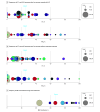Variations and Opportunities in Postnatal Management of Hemolytic Disease of the Fetus and Newborn
- PMID: 39792381
- PMCID: PMC11724339
- DOI: 10.1001/jamanetworkopen.2024.54330
Variations and Opportunities in Postnatal Management of Hemolytic Disease of the Fetus and Newborn
Abstract
Importance: Preventive efforts in pregnancy-related alloimmunization have considerably decreased the prevalence of hemolytic disease of the fetus and newborn (HDFN). International studies are therefore essential to obtain a deeper understanding of the postnatal management and outcomes of HDFN. Taken together with numerous treatment options, large practice variations among centers may exist.
Objectives: To assess variations in postnatal management and outcomes of HDFN among international centers and to identify opportunities to improve care.
Design, setting, and participants: In this international, retrospective, cohort study, 31 expert centers from 22 countries retrieved data on neonates with HDFN managed between January 1, 2006, and July 1, 2021. Statistical analysis was performed from July 19, 2023, to October 28, 2024.
Main outcomes and measures: Main outcomes included the frequency of exchange transfusions, administration of intravenous immunoglobulin, administration of erythropoiesis-stimulating agents, and red blood cell transfusions, as well as the association of gestational age at birth with exchange transfusion frequency and risk factors for adverse neonatal outcomes.
Results: The study included 1855 neonates (median gestational age at birth, 36.4 weeks [IQR, 35.0-37.3 weeks]; 1034 boys [55.7%]), of whom 1017 (54.8%) received any form of antenatal treatment. Most neonates (1447 [78.0%]) had anti-D antibodies. Exchange transfusions were performed in 436 neonates (23.5%), with proportions in exchange transfusion frequency varying from 0% to 78% among centers. Intravenous immunoglobulin was administered to 429 of 1743 neonates (24.6%), with proportions varying from 0% to 100% among centers. A higher gestational age at birth was associated with a reduction in exchange transfusion frequency in neonates with intrauterine transfusion, decreasing from approximately 38.2% (13 of 34) at 34 weeks to 16.8% (18 of 107) after 37 weeks and 0 days. A weekly increase in gestational age at birth was associated with a 43.3% decrease (95% CI, 36.1%-49.7%) in the likelihood of adverse neonatal outcomes, and neonates who received an exchange transfusion were 1.55 (95% CI, 1.10-2.18) times more likely to experience unfavorable outcomes.
Conclusions and relevance: In this cohort study of neonates with HDFN managed at 31 centers in 22 countries, significant practice variations in the postnatal management of HDFN were identified, highlighting the lack of, and need for, consensus. The study suggests that there is a potential beneficial clinical association of waiting for delivery until after 37 weeks and 0 days with frequency of exchange transfusions among neonates with HDFN. The framework to implement international guidelines is provided.
Conflict of interest statement
Figures



Comment in
- doi: 10.1001/jamanetworkopen.2024.54342
References
-
- Le Pichon JB, Riordan SM, Watchko J, Shapiro SM. The neurological sequelae of neonatal hyperbilirubinemia: definitions, diagnosis and treatment of the kernicterus spectrum disorders (KSDs). Curr Pediatr Rev. 2017;13(3):199-209. - PubMed
Publication types
MeSH terms
Substances
LinkOut - more resources
Full Text Sources
Medical

